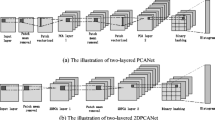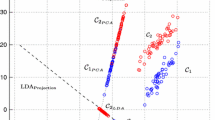Abstract
We focus on two aspects of the face recognition, feature extraction and classification. We propose a two component system, introducing Lattice Independent Component Analysis (LICA) for feature extraction and Extreme Learning Machines (ELM) for classification. In previous works we have proposed LICA for a variety of image processing tasks. The first step of LICA is to identify strong lattice independent components from the data. In the second step, the set of strong lattice independent vector are used for linear unmixing of the data, obtaining a vector of abundance coefficients. The resulting abundance values are used as features for classification, specifically for face recognition. Extreme Learning Machines are accurate and fast-learning innovative classification methods based on the random generation of the input-to-hidden-units weights followed by the resolution of the linear equations to obtain the hidden-to-output weights. The LICA-ELM system has been tested against state-of-the-art feature extraction methods and classifiers, outperforming them when performing cross-validation on four large unbalanced face databases.









Similar content being viewed by others
References
Belhumeur P, Hespanha J, Kriegman D (1997) Eigenfaces versus fisherfaces: recognition using class specific linear projection. IEEE Trans Pattern Anal Mach Intell 19(7):711–720
Bell A, Sejnowski T (1995) An information-maximization approach to blind separation and blind deconvolution. Neural Computat 7:1129–1159
Breiman L, Schapire E (2001) Random forests. Mach Learn 45:5–32
Cai D, He X, Han J (2007) Semi-supervised discriminant analysis. In: Proceeding of the IEEE international conference on computer vision (ICCV), Rio De Janeiro, pp 1–7
Chang CC, Lin CJ (2011) LIBSVM: a library for support vector machines. ACM Transact Intell Syst Technol 2:27:1–27:27. Software available at http://www.csie.ntu.edu.tw/cjlin/libsvm
Chellappa R, Sinha P, Phillips PJ (2010) Face recognition by computers and humans. IEEE Comput 43(2):46–55
Choi JY, Ro YM, Plataniotis KN (2011) A comparative study of preprocessing mismatch effects in color image based face recognition. Pattern Recognit 44(2):412–430
Cortes C, Vapnik V (1995) Support-vector networks. Mach Learn 20(3):273–297
Csato L, Opper M, Winther O (2001) Tap gibbs free energy, belief propagation and sparsity. In: Advances in neural information processing systems. MIT Press, Cambridge
Danmarks-Tekniske-Universitet (2002) Ica:dtu toolbox. http://cogsys.imm.dtu.dk/toolbox/
Draper BA, Baek K, Bartlett MS, Beveridge JR (2003) Recognizing faces with pca and ica. Comput Vision Image Understand 91(1–2):115–137, special Issue on Face Recognition
Graña M (2008) A brief review of lattice computing. In: Fuzzy systems, 2008. FUZZ-IEEE 2008. (IEEE world congress on computational intelligence). IEEE international conference on, pp 1777–1781
Graña M, Villaverde I, Maldonado J, Hernandez C (2009) Two lattice computing approaches for the unsupervised segmentation of hyperspectral images. Neurocomputing 72(10–12):2111–2120
Graña M, Manhaes-Savio A, García-Sebastián M, Fernandez E (2010) A lattice computing approach for on-line fmri analysis. Image Vision Comput 28(7):1155–1161
Graña M, Chyzhyk D, García-Sebastián M, Hernández C (2011) Lattice independent component analysis for functional magnetic resonance imaging. Inform Sci 181(10):1910–1928, special Issue on Information Engineering Applications Based on Lattices
Hall M, Frank E, Holmes G, Pfahringer B, Reutemann P, Witten IH (2009) The weka data mining software: an update. SIGKDD Explorer Newsletter 11(1):10–18
Hansen L, Larsen J, Kolenda T (2001) Blind detection of independent dynamic components. In: Proceedings (ICASSP ’01) 2001 IEEE international conference on acoustics, speech, and signal processing, 2001, vol 5, pp 3197–3200
Hansen LK, Larsen J, Kolenda T (2000) On independent component analysis for multimedia signals. CRC Press, Cambridge
He X, Niyogi P (2003) Locality preserving projections. In: Proceedings of the conference on advances in nerual information processing systems
Heusch G, Marcel S (2010) A novel statistical generative model dedicated to face recognition. Image Vision Comput 28(1):101–110
Hjen-Srensen PA, Winther O, Hansen LK (2002) Mean-field approaches to independent component analysis. Neural Computat 14(4):889–918
Hoerl AE, Kennard RW (1970) Ridge regression: biased estimation for nonorthogonal problems. Technometrics 12(1):55–67
Huang GB, Zhu QY, Siew CK (2004) Extreme learning machine: a new learning scheme of feedforward neural networks. In: Proceedings. 2004 IEEE international joint conference on neural networks, vol 2, pp 985–990
Huang GB, Zhu QY, Siew CK (2006) Extreme learning machine: theory and applications. Neurocomputing 70:489–501
Huang GB, Wang D, Lana Y (2011a) Extreme learning machines: a survey. Int J Mach Learn Cybernet 107–122 (In Press)
Huang GB, Zhou H, Ding X, Zhang R (2011b) Extreme learning machine for regression and multiclass classification. IEEE Transact Syst Man Cybernet Part B: Cybernet 99:1–17
Hulse JV, Khoshgoftaar T (2009) Knowledge discovery from imbalanced and noisy data. Data Knowledge Eng 68(12):1513–1542, including special section: 21st IEEE international symposium on computer-based medical systems (IEEE CBMS 2008)—Seven selected and extended papers on biomedical data mining
Hyvarinen A, Oja E (2000) Independent component analysis: algorithms and applications. Neural Networks 13:411–430
Jun W, Shitong W, Chung Fl (2011) Positive and negative fuzzy rule system, extreme learning machine and image classification. Int J Mach Learn Cybernet 2:261–271. doi:10.1007/s13042-011-0024-1
Kare S, Samal A, Marx D (2008) Using bidimensional regression to assess face similarity. Mach Vision Appl 21(3):261–274
Kim J, Shin HS, Shin K, Lee M (2009) Robust algorithm for arrhythmia classification in ecg using extreme learning machine. Biomed Eng Online 8:31
Lee D, Seung H (1999) Learning the parts of objects by non-negative matrix factorization. Nature 401(6755):788–791
Lienhart R, Maydt J (2002) An extended set of haar-like features for rapid object detection. In: Proceedings of 2002 international conference on image processing, vol 1, IEEE Signal Processing Society, Rochester, pp 900–903
Lu J, Plataniotis K, Venetsanopoulos A, Li S (2006) Ensemble-based discriminant learning with boosting for face recognition. IEEE Transact Neural Netw 17(1):166–178
Mohammed AA, Wu QMJ, Sid-Ahmed MA (2010) Application of wave atoms decomposition and extreme learning machine for fingerprint classification. In: Proceedings of image analysis and recognition, 2010, PT II, Lecture Notes in Computer Science, vol 6112, Springer-Verlag, pp 246–255
Molgedey L, Schuster HG (1994) Separation of a mixture of independent signals using time delayed correlations. Phys Rev Lett 72:3634–3637
Moller MF (1993) A scaled conjugate gradient algorithm for fast supervised learning. Neural Netw 6:525–533
Nefian A (2002) Embedded bayesian networks for face recognition. In: Proceedings of the IEEE international conference on multimedia and expo, vol 2, Lusanne, Switzerland, pp 133–136
Nielsen H (2001) Ucminf—an algorithm for unconstrained, nonlinear optimization. Technical Report on IMM-TEC-0019, IMM, Technical University of Denmark
Opper M, Winther O (2001a) Adaptive and self-averaging thouless-anderson-palmer mean-field theory for probabilistic modeling. Phys Rev E 64(5):056131
Opper M, Winther O (2001b) Tractable approximations for probabilistic models: the adaptive thouless-anderson-palmer mean field approach. Phys Rev Lett 86(17):3695–3699
Pan Y, Ge SS, He H, Chen L (2009) Real-time face detection for human robot interaction. In: RO-MAN 2009: The 18th IEEE international symposium on robot and human interactive communication, vols 1 and 2, pp 15–20
Phillips P, Wechsler H, J Huang PR (1998) The feret database and evaluation procedure for face recognition algorithms. Image Vision Comput 16(5):295–306
Phillips P, Moon H, Rizvi S, Rauss P (2000) The feret evaluation methodology for face recognition algorithms. IEEE Trans Pattern Anal Mach Intell 22:1090–1104
Prosperi MCF, Altmann A, Rosen-Zvi M, Aharoni E, Borgulya G, Bazso F, Sonnerborg A, Schuelter E, Struck D, Ulivi G, Vandamme AM, Vercauteren J, Zazzi M, EuResistVirolab Study Grp (2009) Investigation of expert rule bases, logistic regression, and non-linear machine learning techniques for predicting response to antiretroviral treatment. Antiviral Therapy 14(14):433–442
Qiao L, Chen S, Tan X (2010) Sparsity preserving discriminant analysis for single training image face recognition. Pattern Recognit Lett 31(5):422–429
Ren CX, Dai DQ (2010) Incremental learning of bidirectional principal components for face recognition. Pattern Recognit 43(1):318–330
Riedmiller M, Braun H (1993) A direct adaptive method for faster backpropagation learning: the rprop algorithm. In: IEEE international conference on neural networks, vol 1, pp 586–591
Ritter G, Sussner P, Diazde Leon J (1998) Morphological associative memories. IEEE Transact Neural Netw 9(2):281–293
Ritter G, Urcid G, MS S (2009) Autonomous single-pass endmember approximation using lattice auto-associative memories. Neurocomputing 72(10–12):2101–2110
Ritter GX, Urcid G (2010) A lattice matrix method for hyperspectral image unmixing. Inform Sci 181(10):1787–1803
Schölkopf B, Smola AJ, Williamson RC, Bartlett PL (2000) New support vector algorithms. Neural Computat 12(5):1207–1245
Schölkopf B, Platt JC, Shawe-Taylor JC, Smola AJ, Williamson RC (2001) Estimating the support of a high-dimensional distribution. Neural Comput 13:1443–1471
Shan C, Gong S, McOwan PW (2009) Facial expression recognition based on local binary patterns: a comprehensive study. Image Vision Comput 27(6):803–816
Sun ZL, Choi TM, Au KF, Yu Y (2008) Sales forecasting using extreme learning machine with applications in fashion retailing. Decis Support Syst 46(1):411–419
Tian HX, Mao ZZ (2010) An ensemble elm based on modified adaboost.rt algorithm for predicting the temperature of molten steel in ladle furnace. IEEE Transact Autom Sci Eng 7(1):73–80
Turk M, Pentland A (1991) Eigenfaces for recognition. J Cognit Neurosci 3(1):71–86
Veganzones M, Graña M (2008) Endmember extraction methods: a short review. In: Knowledge-based intelligent information and engineering systems, pt 3, lecture notes in computer science, vol 5179
Villaverde I, Fernandez-Gauna B, Zulueta E (2010) Lattice independent component analysis for mobile robot localization. In: Corchado E, Romay M, Savio A (eds) Hybrid artificial intelligence systems, pt 2, Springer-Verlag, lecture notes in artificial intelligence, vol 6077, pp 335–342
Viola P, Jones M (2001) Rapid object detection using a boosted cascade of simple features. In: Proceedings of the 2001 IEEE computer society conference on computer vision and pattern recognition, 2001. CVPR 2001, vol 1, pp 511–518
Yambor W (2000) Analysis of pca-based and fisher discriminant-based image recognition algorithms. Technical report cs-00-103, Computer Science Department, Colorado State University
Zhou D, Tang Z (2009) Kernel-based improved discriminant analysis and its application to face recognition. Soft Comput 14(2):103–111
Acknowledgments
I. Marques acknowledges the grant received from the Basque Government through the Research Staff Training Program of the Education, University and Research Department.
Author information
Authors and Affiliations
Corresponding author
Rights and permissions
About this article
Cite this article
Marques, I., Graña, M. Face recognition with lattice independent component analysis and extreme learning machines. Soft Comput 16, 1525–1537 (2012). https://doi.org/10.1007/s00500-012-0826-4
Published:
Issue Date:
DOI: https://doi.org/10.1007/s00500-012-0826-4




